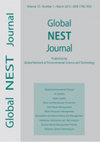Modelling the dispersion of benzene emissions from a proposed ethanol producing facility in Farewell-Oshawa of Toronto, Canada
IF 1.2
4区 环境科学与生态学
Q4 ENVIRONMENTAL SCIENCES
引用次数: 0
Abstract
The production and use of biofuels such as ethanol have been the target of intensive research. One source of ethanol is corn, which is abundant in many countries. In producing ethanol from corn, an assessment of the environmental impact of the process is needed. This study intends to provide insight into benzene emitted from a proposed biofuel plant, its dispersion behavior, and the effects it may have on the immediate environment. Threeseason (January, April, and June) dispersion results of benzene emissions from the proposed ethanol-producing facility are evaluated by using the CALPUFF modelling system. Within the framework of the CALPro software, ambient benzene concentrations are modelled over a 24hour period of exposure by considering the impact of pollutant transformation and removal, and meteorological factors such as wind direction and speed, and temperature. Simulations are performed for the plant area located in Farewell, Oshawa, Ontario, based on the emission and meteorological dataset for the year 2013. The modeling domain covers the area of 30 × 30 km with the grid spacing of 150 m. The number of grid lines is taken as 200 for each axis, and the dispersion of benzene emissions is simulated in nine vertical layers of the domain of study. Based on simulated one-hour and 24-hour average benzene concentrations, pollution dispersion results show that the maximum concentrations are recorded as 4.585 and 0.403 μg/m at 17h00 LST on hourly basis and on 24hour basis, respectively, for the winter season. For the spring season, the highest concentrations are measured as 1.345 and 0.136 μg/m at 21h00 LST for one-hour and 24hour periods, respectively. For the summer season, the peak benzene concentrations are found to be 1.085 and 0.277 μg/m at 01h00 LST. The results indicate that none of the months exceeds the half-hour limit of 7 μg/m set by Ontario Regulation 419/05, but they surpass the Ontario Regulation 419 Schedule 3 limit of 0.01 μg/m for a 24-hour dispersion period. This information may prove invaluable to further research on the impacts of the ethanolproduction process on the environment.加拿大多伦多Fareway Oshawa拟建乙醇生产设施苯排放扩散模型
乙醇等生物燃料的生产和使用一直是深入研究的目标。乙醇的一个来源是玉米,玉米在许多国家都很丰富。在用玉米生产乙醇的过程中,需要对该过程的环境影响进行评估。这项研究旨在深入了解拟建生物燃料工厂排放的苯、其分散行为及其可能对周围环境产生的影响。使用CALPUFF建模系统对拟建乙醇生产设施苯排放的三季(1月、4月和6月)分散结果进行了评估。在CALPro软件的框架内,通过考虑污染物转化和去除的影响,以及风向、风速和温度等气象因素,对暴露24小时的环境苯浓度进行建模。基于2013年的排放和气象数据集,对位于安大略省奥沙瓦市Fareway的厂区进行了模拟。建模区域的面积为30×30km,网格间距为150m。每条轴的网格线数取为200,并在研究区域的九个垂直层中模拟苯排放的扩散。基于模拟的1小时和24小时平均苯浓度,污染扩散结果显示,在17时LST和24小时LST,冬季的最大浓度分别为4.585和0.403μg/m。对于春季,在21时LST下测得的1小时和24小时的最高浓度分别为1.345和0.136μg/m。对于夏季,在01时LST,苯的峰值浓度分别为1.085和0.277μg/m。结果表明,没有一个月超过安大略省第419/05号法规规定的7微克/米的半小时限值,但在24小时的分散期内超过了安大略省第418号法规附表3规定的0.01微克/米限值。这些信息对于进一步研究乙醇生产过程对环境的影响可能是非常宝贵的。
本文章由计算机程序翻译,如有差异,请以英文原文为准。
求助全文
约1分钟内获得全文
求助全文
来源期刊

Global Nest Journal
环境科学-环境科学
CiteScore
1.50
自引率
9.10%
发文量
100
审稿时长
>12 weeks
期刊介绍:
Global Network of Environmental Science and Technology Journal (Global NEST Journal) is a scientific source of information for professionals in a wide range of environmental disciplines. The Journal is published both in print and online.
Global NEST Journal constitutes an international effort of scientists, technologists, engineers and other interested groups involved in all scientific and technological aspects of the environment, as well, as in application techniques aiming at the development of sustainable solutions. Its main target is to support and assist the dissemination of information regarding the most contemporary methods for improving quality of life through the development and application of technologies and policies friendly to the environment
 求助内容:
求助内容: 应助结果提醒方式:
应助结果提醒方式:


